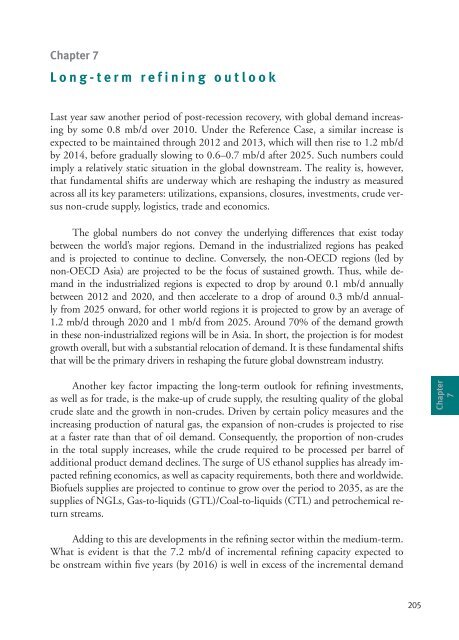World Oil Outlook - Opec
World Oil Outlook - Opec
World Oil Outlook - Opec
- TAGS
- world
- outlook
- opec
- www.opec.org
You also want an ePaper? Increase the reach of your titles
YUMPU automatically turns print PDFs into web optimized ePapers that Google loves.
Chapter 7<br />
Long-term refining outlook<br />
Last year saw another period of post-recession recovery, with global demand increasing<br />
by some 0.8 mb/d over 2010. Under the Reference Case, a similar increase is<br />
expected to be maintained through 2012 and 2013, which will then rise to 1.2 mb/d<br />
by 2014, before gradually slowing to 0.6–0.7 mb/d after 2025. Such numbers could<br />
imply a relatively static situation in the global downstream. The reality is, however,<br />
that fundamental shifts are underway which are reshaping the industry as measured<br />
across all its key parameters: utilizations, expansions, closures, investments, crude versus<br />
non-crude supply, logistics, trade and economics.<br />
The global numbers do not convey the underlying differences that exist today<br />
between the world’s major regions. Demand in the industrialized regions has peaked<br />
and is projected to continue to decline. Conversely, the non-OECD regions (led by<br />
non-OECD Asia) are projected to be the focus of sustained growth. Thus, while demand<br />
in the industrialized regions is expected to drop by around 0.1 mb/d annually<br />
between 2012 and 2020, and then accelerate to a drop of around 0.3 mb/d annually<br />
from 2025 onward, for other world regions it is projected to grow by an average of<br />
1.2 mb/d through 2020 and 1 mb/d from 2025. Around 70% of the demand growth<br />
in these non-industrialized regions will be in Asia. In short, the projection is for modest<br />
growth overall, but with a substantial relocation of demand. It is these fundamental shifts<br />
that will be the primary drivers in reshaping the future global downstream industry.<br />
Another key factor impacting the long-term outlook for refining investments,<br />
as well as for trade, is the make-up of crude supply, the resulting quality of the global<br />
crude slate and the growth in non-crudes. Driven by certain policy measures and the<br />
increasing production of natural gas, the expansion of non-crudes is projected to rise<br />
at a faster rate than that of oil demand. Consequently, the proportion of non-crudes<br />
in the total supply increases, while the crude required to be processed per barrel of<br />
additional product demand declines. The surge of US ethanol supplies has already impacted<br />
refining economics, as well as capacity requirements, both there and worldwide.<br />
Biofuels supplies are projected to continue to grow over the period to 2035, as are the<br />
supplies of NGLs, Gas-to-liquids (GTL)/Coal-to-liquids (CTL) and petrochemical return<br />
streams.<br />
Adding to this are developments in the refining sector within the medium-term.<br />
What is evident is that the 7.2 mb/d of incremental refining capacity expected to<br />
be onstream within five years (by 2016) is well in excess of the incremental demand<br />
205<br />
Chapter<br />
7
















